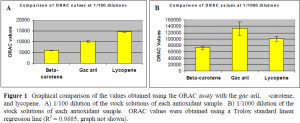Katherine Secrest and Dr. Kim O’Neill, Microbiology and Molecular Biology
Introduction
The red fruit Momordica cochinchinensis (gac) grows indigenously throughout Southeast Asia and possesses naturally high levels of provitamin A carotenoids, beta-carotene and lycopene. In much of Southeast Asia, rural populations suffer from chronic vitamin A deficiency.1 Currently, government programs distribute vitamin A capsules as supplements, but long-term solutions lie in food-based alternatives. At this time, gac fruit is only consumed during annual festivals when the red pulp of the fruit is used to color rice. Consumption of gac fruit has been shown to significantly increase plasma beta-carotene concentrations and could provide an inexpensive, food-based alternative to improving the vitamin A deficiency problem vexing many developing Asian countries.2
Many reactive oxidative species (ROS), including hydroxyl and peroxyl radicals, as well as superoxide anions, are known to cause damage to DNA, proteins, and other macromolecules. ROS are caused by a variety of assaults on the cell, including high oxygen tension, ultraviolet light, oxidizing chemicals, and inflammatory responses.3 Damage to DNA that evades the DNA repair mechanisms of cells is thought to be an underlying cause of cancer and aging. Antioxidants aid cells by scavenging ROS and preventing intracellular damage. Both beta-carotene and lycopene have been shown to provide high levels of antioxidant activity, lycopene having almost 10 times more than beta-carotene.4
Results and Discussion

Our initial experiments with the TOSC assay revealed many limitations to using the TOSC assay. We found that the assay is limited to measuring the antioxidant activity of samples soluble in only water, phosphate buffer, or DMSO.
Since both b-carotene and lycopene are only slightly soluble in DMSO, we were unable to obtain accurate results on their antioxidant activity. Table 1 shows the values obtained from the TOSC analysis of Trolox (vitamin E analogue) and gac aril (both samples were dissolved in DMSO). The comparative TOSC values show that the gac aril maintains a peroxyl radical scavenging capacity 5.4 times greater than Trolox.

Because our antioxidants required the use of ethanol as a solvent, we utilized the ORAC assay, which has the capacity to analyze antioxidants in a variety of solvents. We compared the gac aril with its major carotenoid constituents, beta-carotene, and lycopene. The results we obtained with the ORAC assay were surprising. Stock solutions of all samples were diluted 1/100 and 1/1000. Figure 1A shows that at a 1/100 dilution, lycopene exhibited the highest ability to scavenge peroxyl radicals (2.4 and 1.4 times as much as beta-carotene and the gac aril, respectively). However, at a dilution of 1/1000, the gac aril provided the highest peroxyl radicalscavenging capacity (1.8 and 1.3 times as much as beta-carotene and lycopene, respectively), as shown in Figure 1B.
Future Research
We have recently come across methodology in the literature that will help us obtain more accurate results with the ORAC assay. We will make stock solutions of our hydrophobic antioxidants in ethanol or methanol, and then we will use 75 mM phosphate buffer (pH 7.4) for our dilutions. This should minimize the effect of the organic solvent on our results. Also, we plan to use the gac aril, beta-carotene, and lycopene to perform cytotoxicity tests on human cancer cell lines (MCF-7, Raji, and HL-60) to provide evidence of the nutritional benefit of the gac fruit in preventative cancer.
References
- D. McLaren. Global occurrence of vitamin A deficiency. In: Vitamin A and its controls. J. C. Bauernfield, ed. New York: Academic Press, 1-18 (1986).
- L. T. Vuong, S. R. Dueker, and S. P. Murphy. Plasma b-carotene and retinal concentrations of children increase after a 30-d supplementation with the fruit Momordica cochinchinensis (gac). Am J Clin Nutr. 75: 872-9 (2002).
- T. Armeni, M. Battino, A. Stronati, A. Pugnaloni, G. Tomassini, G. Rosi, G. Biagini, G. Principato. Total antioxidant capacity and nuclear DNA damage in keratinocytes after exposure to H2O2. Biol Chem. 382: 1697-705 (2001).
- J. Shi, and M. L. Maguer. Lycopene in tomatoes: chemical and physical properties affected by food processing. Crit Rev Biotechnol. 20: 293-334 (2000).
